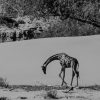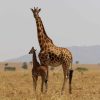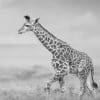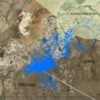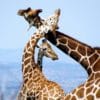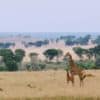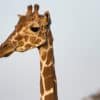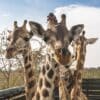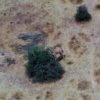Helladotherium, a three-metre-tall antelope-like animal, which once roamed the plains and forests of Asia and Europe between the Eocene and Oligocene epochs 30-50 million years ago, is the forefather of the two remaining members of the Giraffidae family: the giraffe we know today, and the okapi. To date, more than ten fossil genera have been discovered, revealing that by the Miocene epoch, 6-20 million years ago, early deer-like giraffids were yet to develop the characteristic long neck of today’s giraffe.
Like okapi, hippo, oryx, buffalo and cattle, the giraffe is an even-toed ungulate. Rhino, zebra and horses are odd-toed ungulates. As the world’s tallest animal and largest ruminant (an animal that partly digests its food, then regurgitates it to chew as ‘cud’), it belongs to:
Class: Mammalia (mammals)
Order: Artiodactyla (even-toed ungulates)
Family: Giraffidae
Genus: Giraffa
In 2016 the IUCN completed the first detailed assessment of the conservation status of giraffe, revealing that their numbers are in peril. This was further emphasised when the majority of the IUCN recognised subspecies were assessed in 2018 – some as Critically Endangered. While this update further confirms the real threat to one of Africa’s most charismatic megafauna, it also highlights a rather confusing aspect of giraffe conservation: how many species/subspecies of giraffe are there?
The IUCN currently recognises one species (Giraffa camelopardalis) and nine subspecies of giraffe, which is historically based on outdated assessments of their morphological features and geographic ranges. The subspecies are thus divided: Angolan giraffe (G. c. angolensis), Kordofan giraffe (G. c. antiquorum), Masai giraffe (G. c. tippleskirchi), Nubian giraffe (G. c. camelopardalis), Reticulated giraffe (G. c. reticulata), Rothschild’s giraffe (G. c. rothschildi), South African giraffe (G. c. giraffa), Thornicroft’s giraffe (G. c. thornicrofti), and West African giraffe (G. c. peralta).
However, the Giraffe Conservation Foundation (GCF), together with its partner Senckenberg Biodiversity and Climate Research Centre (BiK-F), has performed the first-ever comprehensive DNA sampling and analysis (genomic, nuclear and mitochondrial) of all major natural populations of giraffe throughout their range in Africa. As a result, an update of the traditional taxonomy now exists. This study revealed that there are four distinct species of giraffe, and five subspecies. The four distinct species are Masai giraffe (G. tippelskirchi), Northern giraffe (G. camelopardalis), Reticulated giraffe (G. reticulata) and Southern giraffe (G. giraffa). The Angolan giraffe (G. g. angolensis) and South African giraffe (G. g. giraffa) are the two subspecies of the Southern giraffe. Nubian giraffe (G. c. camelopardalis), Kordofan giraffe (G. c. antiquorum) and West African giraffe (G. c. peralta) are the three subspecies of the Northern giraffe. Rothschild’s giraffe is genetically identical to the Nubian giraffe. As the nominate species, Nubian giraffe takes precedence and Rothschild’s giraffe is thus subsumed into it.
Preliminary data suggests that the Thornicroft’s giraffe is genetically similar to the Masai giraffe. However, additional research is necessary to determine whether Thornicroft’s giraffe are genetically identical to Masai giraffe, or should be considered a separate subspecies of Masai giraffe. In all of GCF’s conservation work and publications, based on this research, we use the updated giraffe taxonomy of the four species, while the IUCN still refers to the traditional concept of one species and nine subspecies.
All four giraffe species and their subspecies live in geographically distinct areas throughout Africa. While some of these species have been reported to hybridise in zoos, there is very little evidence that this occurs readily in the wild.
Read more about the four species of giraffe.


